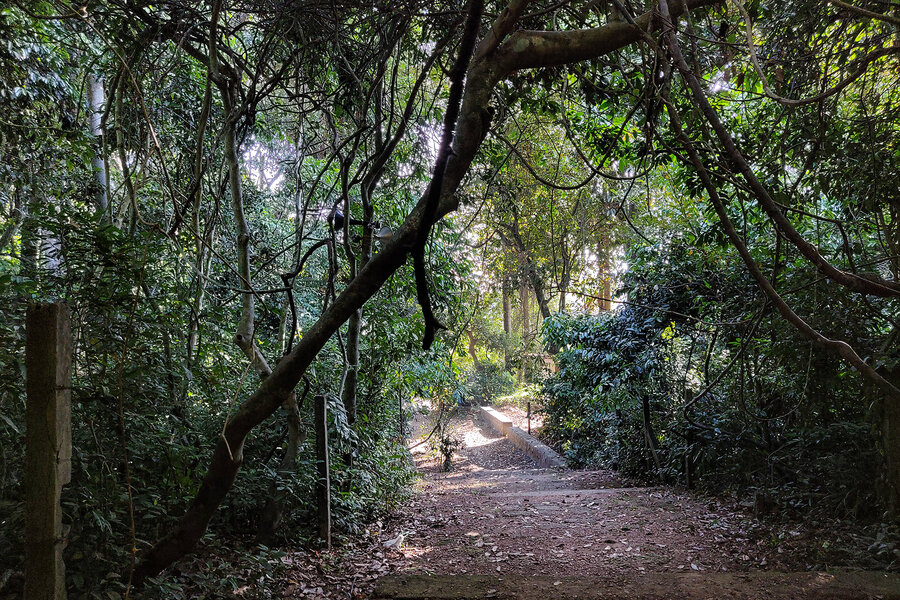India’s sacred groves are home to forest god shrines – and endangered species
Loading...
| Venmony, India
Thick corded trunks snake upward from the ground, reaching toward an overhead lattice of branches splotched with green. If it weren’t for the precariously perched speakers blaring hymns, people may miss this entrance to the 500-year-old sacred grove known as Sharngakavu.
A deity revered locally as Vana Durga, whose name loosely translates to “forest goddess,” is believed to have been found in a stone within the forest. Because of that, surrounding communities have preserved the grove for generations.
“There is some [cosmic] attraction within the forest, due to which our community feels compelled to protect and conserve it,” says Anil Kumar, who works at the Sharngakavu Devi temple located within the 8-acre grove, where an absence of timber logging or hunting has allowed a rich ecosystem to flourish. It is home to the endangered bonnet monkeys and other species endemic to the Western Ghats mountains, which run down the western edge of India.
Why We Wrote This
A story focused onIn India, sacred groves have become bastions of biodiversity. But how effective is spiritual belief as a tool for conservation?
There are others like it, with 1,096 sacred groves scattered throughout Kerala state, each managed by local families or temples. Researchers have found that, in addition to housing vulnerable species, these virgin forest patches act as reservoirs, helping boost a community’s resilience to extreme flooding. As climate change exacerbates extreme weather and biodiversity loss, preserving these groves is critical.
“Cultural beliefs and taboos continue to be the best conservation strategies against the exploitation of local sacred groves,” says Kavya Jeevan, co-author of a 2023 study in the Indian Journal of Traditional Knowledge that found Sharngakavu housed vulnerable and endangered species.
Yet such strategies are far from perfect. As young Keralites’ interest in religious tradition declines, so too have the size and number of sacred groves, which in 1956 numbered around 10,000.
Changing social fabric
Dead leaves crunch under Natarajan Panicker’s feet as he steps into a grove dedicated to the worship of snakes, a common Kerala tradition. Inside, vines wrap themselves around a modest enclosure for the shrine of the grove’s goddess.
“The grove has reduced a lot,” says Mr. Panicker, head of the multifamily trust that manages the property. “People have sold the land and moved away.”
Fewer than half of South Indians (including those in Kerala) say they pray daily, according to a recent Pew Research study. While the grove was a significant part of the septuagenarian’s childhood, his children only visited during the annual new year festival in April.
Indeed, younger generations who migrate for work are not nearly as interested in keeping local traditions alive, often considering the groves and their upkeep a burden. Mr. Panicker routinely fields off his sons’ requests that he give up responsibility of the grove and move to the city of Pune where they have now settled.
Combined with an increased demand for land, these shifting attitudes have led to the disappearance of hundreds of family-owned groves in Kerala. Many families bypass lingering taboos by transferring a grove’s deity – as represented by a statue or stone – to a local temple before selling or clearing the property.
Meanwhile, research has found that groves managed by temples, such as Sharngakavu, fare better.
A passive protection
A few years ago in Venmony, the government was pushing to clear a portion of Sharngakavu for a bridge project. But continued protests from the community forced authorities to tweak their plan to exclude the grove.
When asked, community members say they don’t do anything special to preserve the forest, just that they do not damage it for fear of invoking the goddess’s wrath. “The community’s protection [of the grove] is a passive one,” says N.U. Namboothiri, a practicing lawyer who grew up in the region and is part of a resident trust that oversees temple management. “They have attributed divinity to the temple and the kavu [sacred groves] behind it.”
Yet the grove has not gone untouched.
Over the past decade, auditoriums, toilets, and parking areas have been built in and around the temple, often at the expense of a stray tree or shrub, to maximize accessibility and ensure devotees’ comfort.
Those who grew up around the Sharngakavu talk of thicker foliage and denser paths. “When I visited the grove 36 years ago, it was difficult to walk down,” says Devaki, a temple devotee who goes by one name, as she ambles down recently constructed steps.
The additions underscore a key dilemma in sacred grove conservation. “When communities are posed with the question of whether the grove should be preserved or the temple, they will choose the temple,” says Dr. Jeevan.
Harnessing sacrality
That’s not to say sacrality cannot work in tandem with environmental goals. In fact, most conservation groups still focus on temple-owned groves, rather than on those managed by families, because their local popularity offers a better shot at long-term conservation.
The Venmony community has planted trees in the grove, though “species like sal and peepal that are commonly associated with Hindu beliefs are more likely to be conserved as opposed to wild and endemic species, which do not serve the temple’s purpose,” says Dr. Jeevan.
Another intervention led by the M S Swaminathan Research Foundation, a nonprofit promoting science-backed rural development, populated sacred groves in Kerala’s Wayanad district with medically and culturally significant plant species, chosen based on the microclimate of the region. The organization was also able to weed out invasive species in the Wayabad groves – an issue that residents of Venmony have also recognized as a threat to their own sacred space.
But especially with religious beliefs fading, Dr. Jeevan says experts must build awareness about the importance of conserving groves for conservation’s sake. For researchers, this means an urgent need to understand and communicate the ecosystem services provided by groves.







